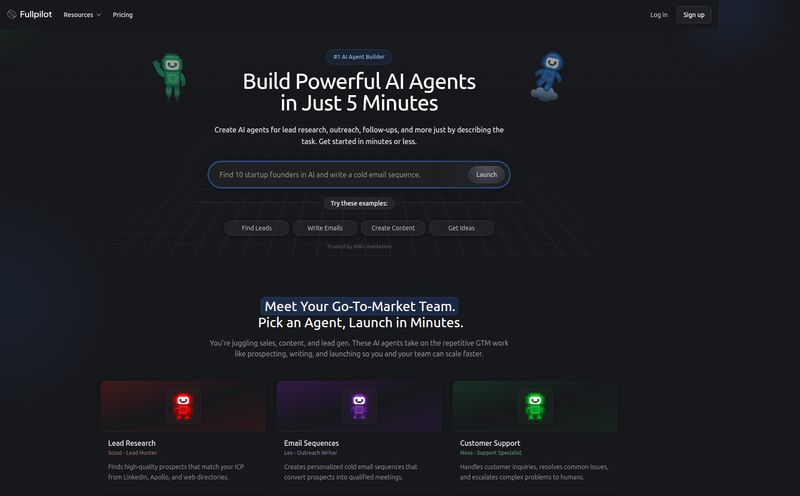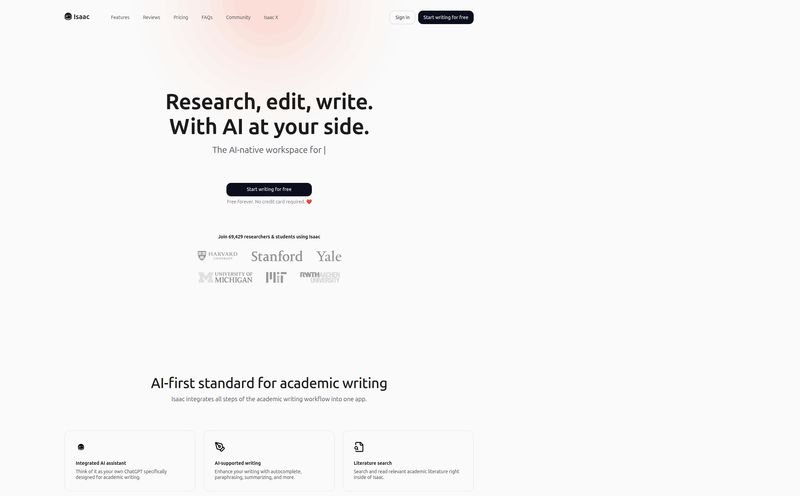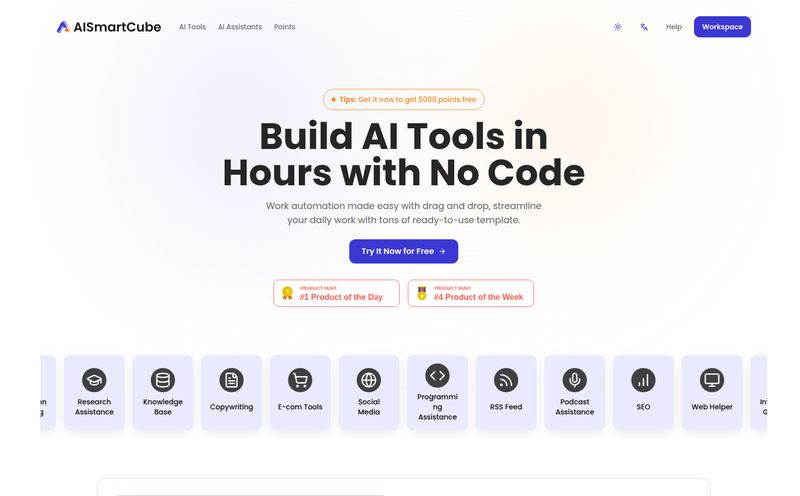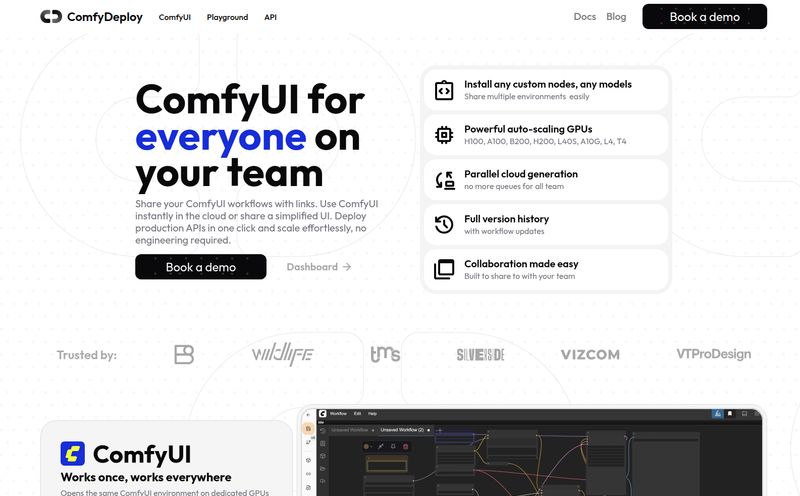How many of you open your inbox in the morning and feel a slight sense of dread? It’s a mix of actual important stuff, a mountain of “reply-alls” that have nothing to do with you, and a ton of newsletters you swear you’ll read “later.” For years, my email has been less of a communication tool and more of a digital chore list I’m constantly failing to complete.
I’ve tried every trick in the book. Filters, folders, the 'mark all as read' Hail Mary. Nothing stuck. The real problem wasn't just the volume; it was the manual labor. Copying an invoice number into a spreadsheet. Forwarding a new lead to our team's Slack channel. Manually creating a Trello card from a client request. Each action is tiny, but they add up to hours of soul-crushing administrative work every single week.
So, when I stumbled upon a tool called Dropflow, with its bold claim of turning emails into action, my inner SEO-slash-productivity-nerd sat up a little straighter. An AI for my inbox? I’ve been burned before, but I’m a glutton for punishment. I had to see what this was all about.
So, What is Dropflow, Really?
Imagine you have a super-smart personal assistant who lives in your inbox. You can forward any email to this assistant, and they'll instantly read it, understand what's important, and put that information exactly where it needs to go. That’s Dropflow in a nutshell.
It’s not just another filtering system. It’s an AI-powered email automation tool that acts as a bridge between your inbox and the other apps you use to actually get work done. You forward an email to a special Dropflow address, and its AI gets to work extracting or summarizing the key info. From there, it automatically sends that structured data to places like Google Sheets, Slack, Notion, Trello, or even a custom webhook for the more tech-savvy among us. It's like installing digital plumbing that connects the firehose of your email directly to the places that matter.
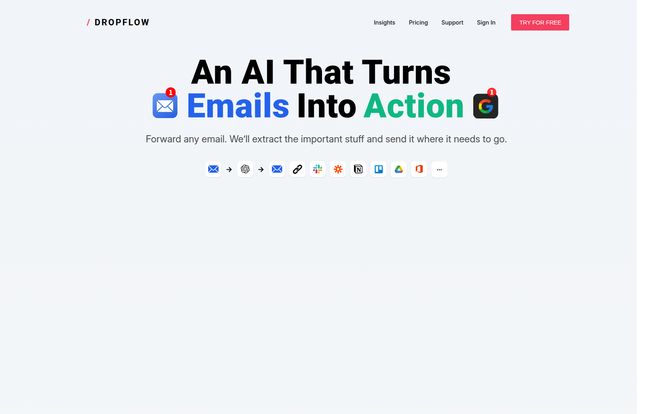
Visit Dropflow
How Dropflow Transforms Emails into Actionable Data
This is where the magic happens. The process is deceptively simple, which I’ve learned is the hallmark of a great tool.
The AI Extraction Engine
This isn't your grandpa's keyword filter. Dropflow's AI is designed to understand context. Let's say you get an email with an invoice attached. Instead of you having to open it, find the invoice number, the amount due, and the due date, you just forward the whole thing to Dropflow. You can set up a “flow” that tells the AI: “Hey, when you see an email like this, grab the invoice number, total amount, and client name.” And poof. It does it. Every single time.
Connecting to Your Favorite Tools
Getting the data out is one thing, but where does it go? This is the other half of the equation. Dropflow integrates directly with the platforms where work actually happens. Think about it:
- New Sales Leads: A contact form submission hits your inbox. Forward it to Dropflow, and it can instantly create a new record in your Google Sheets lead tracker and post a notification in your #sales channel on Slack. No more leads falling through the cracks.
- Invoice Processing: Get an invoice from a contractor? Forward it, and Dropflow adds a new row to your finance sheet with the vendor, amount, and due date, and maybe even creates a task in Trello for your accountant.
- Client Feedback: A customer sends an email with some feedback. You can have Dropflow summarize it and add it to a specific page in Notion where you collect testimonials or feature requests.
The possibilities are pretty broad, and it’s all about eliminating that manual, error-prone step of transferring information from point A to point B.
My Experience: Setting Up a Flow in Under a Minute
Their site claims you can “Create your first flow in 30 seconds.” As a seasoned marketer, I'm naturally skeptical of such bold claims. But I have to hand it to them, they're not far off.
I decided to test it with a common pain point: tracking my software subscription receipts for tax time. I signed up (with Google, super easy) and was prompted to create a flow. I chose a template for 'Invoice Processing'. It asked me what data I wanted to pull—I chose 'Sender', 'Total Amount', and 'Service'. Then it asked where to send it. I connected my Google account and pointed it to a new Google Sheet I named “2024 Receipts.”
The whole thing took maybe 45 seconds. It gave me a unique, slightly gibberish-looking email address. I forwarded a recent receipt from Ahrefs to that address, held my breath for a moment, and then checked my spreadsheet. And there it was. A new row, perfectly formatted. It felt... well, it felt like a little bit of magic.
Who is Dropflow For? And Who Should Probably Skip It?
Look, no tool is perfect for everyone. After playing around with it, I have some strong opinions on who would get the most bang for their buck here.
Perfect for Freelancers and Small Teams
If you're a solopreneur or part of a small, agile team, Dropflow could be a game-changer. You're likely wearing multiple hats—sales, accounting, project management—and your inbox is the chaotic hub of it all. Automating lead tracking, invoice logging, or client requests could genuinely free up hours a week. Time you could spend on billable work instead of admin.
A Lifesaver for Specific Departments
Even in a larger company, certain departments could run this on their own. I’m thinking:
- HR: Imagine automating the initial parsing of job applications that come in via email. You could pull the applicant's name, the position they're applying for, and a link to their portfolio directly into a spreadsheet or Trello board.
- Finance: The invoice example is a no-brainer. It standardizes how invoices are logged, reducing manual entry errors.
- Marketing: Quickly capture user-generated content, press mentions, or partnership inquiries from your inbox and route them to the right place.
Maybe Not for Enterprise Power Users
Here’s the reality check. The Pro plan caps out at 200 emails per month. If you’re a massive corporation looking to process thousands of emails a day, this isn't going to cut it. You'd be looking at a more robust, and frankly more expensive, enterprise-grade solution like a full custom setup with a tool like Zapier or even custom development. Dropflow's strength is its simplicity and focus, not its scale.
The Nitty-Gritty on Dropflow Pricing
Pricing is always the million-dollar—or in this case, four-euro—question. Dropflow keeps it simple, which I appreciate. Interestingly, when I tried to find their dedicated pricing page to double check, I hit a 404 error. A little hiccup, but the info on the homepage is clear enough.
| Plan | Price | Key Features |
|---|---|---|
| Free | €0 / month | 1 Flow from a template, 5 emails/month, 1 sending address. |
| Pro | €4 / month | Up to 20 customizable flows, 200 emails/month, multiple destinations, team features, reporting, & more. |
| Customization | Starting from €5 / month | For specific integrations or needs beyond the standard plans. |
The Free plan is, to be blunt, more of a trial. 5 emails a month is just enough to test it out and see if it works for you. The real value starts with the Pro plan. At €4 a month (that's less than a fancy coffee), 200 automated emails is a fantastic deal for the target audience. The time you save on just a handful of tasks would easily justify the cost.
The Good, The Bad, and The Automated
So let’s wrap this up. I'm genuinely impressed with the core idea and execution. The automation is smooth, the setup is a breeze, and it integrates with the tools most of us are already using. It saves a ton of time on those repetitive, low-value tasks that clog up our workdays. But, it's not without its limitations. The free plan is quite restrictive, acting more as a demo than a functional long-term option for anyone with even a mild email flow. The 200 email/month cap on the Pro plan is generous for freelancers or very small businesses, but it is a hard ceiling that you'll need to be aware of. Anyone needing more advanced, multi-step logic might find it a bit basic compared to a full-blown automation platform.
Dropflow vs. The Competition
Some might say, "Why not just use Zapier or Make?" It's a fair question. Those tools are incredibly powerful. But they're also complex. They are the Swiss Army knives of automation. Dropflow, by contrast, is more like a perfectly crafted chef's knife. It’s designed for one primary purpose: parsing incoming emails. Its entire user experience is built around that single, focused task, making it significantly faster and easier to set up for email-specific workflows. For the non-technical user who just wants to get data out of Gmail and into a spreadsheet, Dropflow is far less intimidating.
Final Thoughts: Is Dropflow the Inbox Hero We Need?
After spending some time with it, I'm a convert. Dropflow isn't trying to solve every automation problem in the world. It’s solving one of the most common and annoying ones: freeing the valuable data trapped inside your inbox. It’s a simple, elegant, and affordable solution for a problem that plagues almost every professional.
If you're a freelancer, run a small business, or manage a team that's drowning in manual email processing, you should absolutely give Dropflow a try. The free plan is enough to prove its value. You might just find that for the price of a latte, you can buy back hours of your life. And that's an ROI I can get behind.
Frequently Asked Questions about Dropflow
- Is Dropflow difficult to set up?
- Not at all. In my experience, you can genuinely set up your first automated workflow in about a minute. The interface is clean and walks you through connecting your apps and choosing what data to extract.
- Can Dropflow process email attachments like PDFs or images?
- The primary focus seems to be on extracting text content directly from the email body. While it handles emails with attachments, advanced data extraction from within a PDF, for instance, might be a more complex feature that would fall under their custom plans.
- What happens if I go over my 200 email limit on the Pro plan?
- Most SaaS platforms will either stop the automation until the next billing cycle or offer an option to upgrade to a higher tier. Given Dropflow's current structure, your flows would likely pause. It's best to monitor your usage via their monthly reporting.
- Is it secure to give a tool access to my emails?
- This is a valid concern for any third-party tool. Dropflow works by you proactively forwarding specific emails to it, rather than it having full, open access to read your entire inbox. This model provides a significant layer of security and control on your end.
- Can I use Dropflow with any email provider?
- Yes! Since the mechanism is based on forwarding emails to a specific Dropflow address, you can use it with Gmail, Outlook, ProtonMail, or any email client that allows you to forward messages.
- Is the €4 Pro plan really worth it?
- In my opinion, yes. If it saves you even just one hour of manual data entry per month, it has already paid for itself. For most freelancers and small businesses, the time savings will be far greater than that.
